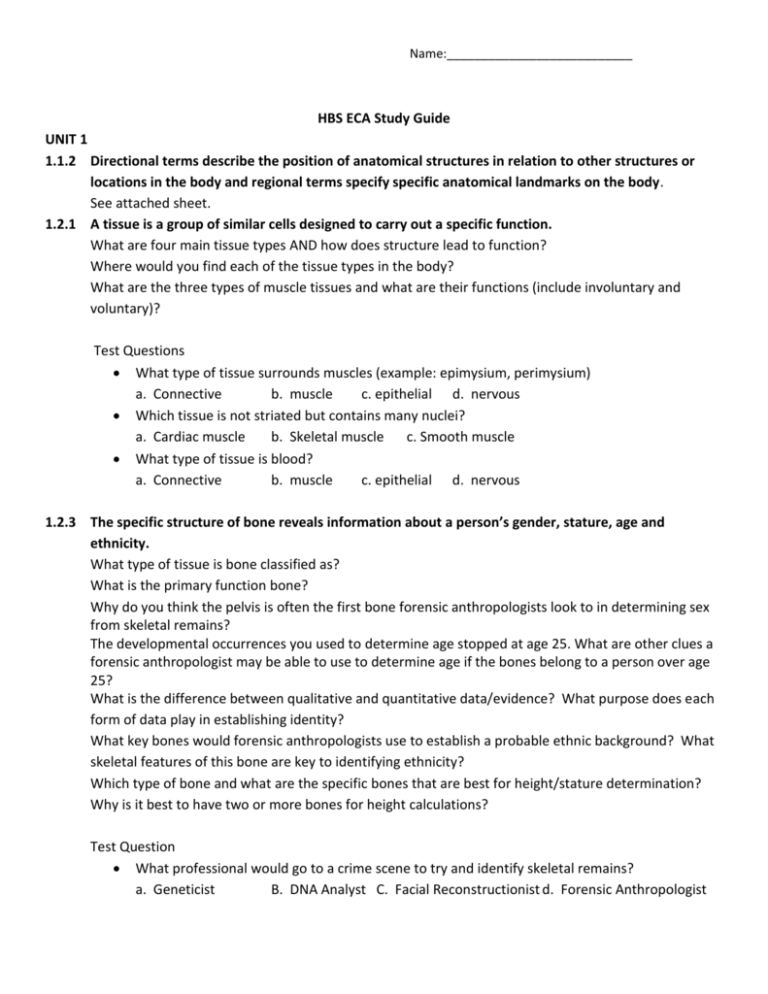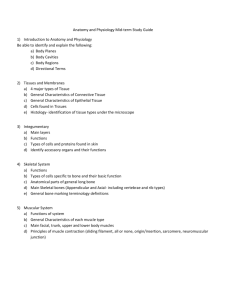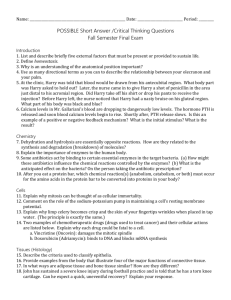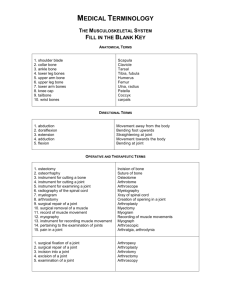Name: HBS ECA Study Guide UNIT 1 1.1.2 Directional terms
advertisement

Name:___________________________ HBS ECA Study Guide UNIT 1 1.1.2 Directional terms describe the position of anatomical structures in relation to other structures or locations in the body and regional terms specify specific anatomical landmarks on the body. See attached sheet. 1.2.1 A tissue is a group of similar cells designed to carry out a specific function. What are four main tissue types AND how does structure lead to function? Where would you find each of the tissue types in the body? What are the three types of muscle tissues and what are their functions (include involuntary and voluntary)? Test Questions What type of tissue surrounds muscles (example: epimysium, perimysium) a. Connective b. muscle c. epithelial d. nervous Which tissue is not striated but contains many nuclei? a. Cardiac muscle b. Skeletal muscle c. Smooth muscle What type of tissue is blood? a. Connective b. muscle c. epithelial d. nervous 1.2.3 The specific structure of bone reveals information about a person’s gender, stature, age and ethnicity. What type of tissue is bone classified as? What is the primary function bone? Why do you think the pelvis is often the first bone forensic anthropologists look to in determining sex from skeletal remains? The developmental occurrences you used to determine age stopped at age 25. What are other clues a forensic anthropologist may be able to use to determine age if the bones belong to a person over age 25? What is the difference between qualitative and quantitative data/evidence? What purpose does each form of data play in establishing identity? What key bones would forensic anthropologists use to establish a probable ethnic background? What skeletal features of this bone are key to identifying ethnicity? Which type of bone and what are the specific bones that are best for height/stature determination? Why is it best to have two or more bones for height calculations? Test Question What professional would go to a crime scene to try and identify skeletal remains? a. Geneticist B. DNA Analyst C. Facial Reconstructionist d. Forensic Anthropologist Name:___________________________ 1.3.1 Restriction enzymes recognize and cut specific sequences in DNA. Gel electrophoresis separates DNA fragments based on size and is used in Restriction Fragment Length Polymorphism (RFLP) analysis. What is the structure(components) and function of DNA? What factor(s) determine the speed by which DNA fragments will move through an electrophoresis gel? What are restriction enzymes and how are the names of restriction enzymes derived? Why would it be important to use more than one restriction enzyme when performing an RFLP analysis? In terms of positive and negative poles, describe the direction DNA fragments would move through an electrophoresis gel chamber and explain why. In reference to the use of restriction enzymes, describe the terms sticky ends and blunt ends. What is PCR and what is its role in DNA analysis? Briefly describe the three phases in the PCR process. Test Question Look at the results obtained from a gel electrophoresis. What is the relationship of Son 1(S1) to Mom & Dad? a. Biological Son of Mom & Dad c. Biological Child of Mom only d. Biological Child of Dad only The following picture represents a strand of DNA (no letters, just a line). The letters represent the locations at which a restriction enzyme has cut the DNA. The numbers represent the number of bases between each fragment/cut. E = EcoRI B = Bam H = HindIII E b. adopted B H 15 25 How many base pairs are between the cut of EcoRI and Bam? Name:___________________________ Look at the following picture. How many base pairs are on this plasmid? How many base pairs are between Site 2 and Site 3 (going clockwise)? UNIT 2 2.1.2 The two main subdivisions of the nervous system are the central nervous system (CNS), brain and spinal cord, and the peripheral nervous system (PNS), all nervous tissues outside the brain and spinal cord. What are the two main subdivisions of the nervous system and what areas of the body make up these two subdivisions? How do the two main subdivisions of the nervous system work together to control the body? 2.1.3 Each region within the brain helps control and regulate specific functions in the body. What are the functions of the following regions of the brain? a. Cerebrum b. Cerebellum c. Brain Stem d. Temporal e. Frontal f. Parietal g. Occipital Test Question If a person is having problems reasoning through a math problem, what part of the brain is not functioning properly? a. Frontal Lobe b. Parietal Lobe c. Occipital Lobe d. Limbic Lobe Name:___________________________ 2.2.1 The nervous system relies on specialized cells called neurons to pass signals to and from the brain and spinal cord. Label the parts of the neuron using the following terms: Dendrites, cell body, nucleus, node of Ranvier, axon, myelin sheath, Schwann cell, axon terminal. How do the different types of neurons work together to send and receive signals? You see a piece of paper on the floor that needs to be picked up and put in the trash. What types of neurons would be involved in seeing the paper, picking it up, and placing it in the trash? 2.2.2 An action potential is an electrical signal that is generated by the movement of ions across the cell membrane of a neuron. How are electrical signals created and transmitted in the human body. Describe the roles of ions in creating electrical impulses in the human body. View the following animation. http://highered.mcgrawhill.com/sites/0072495855/student_view0/chapter14/animation__the_nerve_impulse.html Test Question Take the quiz found at http://highered.mcgrawhill.com/sites/0073031208/student_view0/chapter54/multiple_choice.html Not every question you will be able to answer but there are a lot that are very good for you to review. 2.3.1 The endocrine system helps the body communicate through the use of chemical signals called hormones. What is a hormone? How do hormones interact with target cells? 2.3.1/2.3.2 Hormones help maintain homeostasis through feedback loops. A hormone imbalance can lead to disease or dysfunction. How do feedback loops help regulate the action of hormones? Explain how the body decreases blood glucose levels if they are too high? too low? Name:___________________________ Explain how the body decreases thyroid hormone levels if they are too high? too low? How does a hormone imbalance lead to disease? Give three specific examples. 2.4.1 The structures within the human eye work to focus and process light. How is light focused by the eye? (make sure you look at the structures of the eye) How do the eye and brain work together to process what we see? How does the eye perceive depth, color and optical illusions? Test Question Where are the sensory structures in the eye located that are stimulated by the image that is in front of you? a. Retina b. corena c. lens d. pupil UNIT 3 3.2.1 The digestive system consists of the gastrointestinal tract and the accessory digestive organs which function together to chemically and mechanically digest food, absorb water and nutrients, and remove wastes. What are the functions of the digestive system? Label the organs of the digestive system. Next to each to each structure/organ, identify its function as one or more of the following: chemically digest food, mechanically digest food, absorb water and nutrients, and/or remove wastes. Test Question Using the diagram, which of the digestive organs IS involved in chemical digestion? 3.2.1 Specific enzymes digest carbohydrates, fats and proteins at sites along the digestive tract. How do enzymes assist the process of digestion? Which enzymes digest carbohydrates, fats, and proteins? Name:___________________________ Identify the sites along the digestive tract that each macromolecule is broken down. (label on the picture above with the enzymes) 3.2.5 When a process in the body requires energy, ATP is broken down to liberate energy stored in its chemical bonds. Label the parts of the ATP molecule. Where is the energy located in the ATP molecule? Indicate on your drawing above where the energy is being stored. What is the equation for the breakdown of ATP and the release of energy? 3.3.1 The structure of the lungs and the close association between the lungs and the vessels of the cardiovascular system facilitate the transport of oxygen to all cells in the body. The transfer of oxygen and carbon dioxide molecules between the lungs bloodstream, and cells is by simple diffusion and is dependent on concentration gradients. Describe alveoli and bronchioles. What happens in these structures? Why are the vessels of the cardiovascular system wrapped multiple times around the bronchioles and alveoli? Are there both arterial and venous capillaries around each alveolar sac? Use the principles of diffusion to explain why oxygen molecules in the tissues of the lung go into the blood, and then in other tissues the oxygen molecules leave the blood. 3.4.5 Malfunctions in the body can be identified through noticeable changes in the composition of urine and these changes can be detected through urinalysis. What is analyzed in a macroscopic examination of a urinalysis? What specific properties are analyzed in a chemical analysis of a urinalysis? What do the levels of these properties indicate? Explain the microscopic examination of a urinalysis. UNIT 4 4.1.1 A joint is the location at which two or more bones connect, allowing movement and providing support to the human skeleton. Joints can be classified by either their structure or their function. What are examples of each of the following and describe movement (freely moveable, slightly moveable or immoveable): a. Fibrous b. Cartilaginous c. Synovial Name:___________________________ Test Question List the following joints (fibrous, synovial, cartilaginous) from MOST moveable to LEAST moveable. 4.2.1 Through contraction and relaxation, the three different types of muscle tissue - skeletal, cardiac, and smooth - produce body movements, stabilize body position, move substances within the body and regulate heat. What is the functions of muscles in the body? 4.2.2 1. Fill in the chart below. Type of muscle Striations? (Y/N) Voluntary? (Y/N) Skeletal Muscle Location in Body Function in Body Histology Smooth Muscle Cardiac Muscle 4.2.4/4.2.5 Calcium ions and ATP play a role in the contraction of muscle fibers. What does calcium bind to within the muscle fiber and why is ATP needed for a muscle contraction? List the sequence of how a muscle contraction occurs. When does the myosin head return back to its original place (not bound to the actin fiber)? What chemicals are needed for a muscle contraction to occur? 4.3.2 The structure of arteries, veins, and capillaries relates directly to the function of each vessel and to the amount of pressure exerted on the vessel walls. What do you notice about the width of an artery wall versus the width of a vein wall? Why does this make sense given the function of the vessels? Capillaries function in gas exchange. Their tissue is very thin. Why? Which artery do you think is made of thicker muscle, the aorta or the pulmonary artery? Why? Describe two ways blood is helped back to the heart in veins. Mention relevant body systems. 4.3.4 Changes in cardiac output, the amount of blood that is pumped out by the ventricles per minute, often signal diseases of the heart and these changes can impact the function of other body systems. What are some factors that can increase or decrease the heart rate and the beat you feel at each pulse point? Athletes often have a very low resting heart rate. What does this tell you about the health of their heart? Explain. What are consequences of having a low cardiac output? How will other body systems be affected? Dehydration reduces blood volume. How would this affect cardiac output? Explain Name:___________________________ 4.3.5 Increased blood pressure in vessels can indicate possible blockages and these blockages can interrupt blood flow to an organ or limb. What is your ABI? What does this value tell you about your risk of peripheral artery disease? Explain how PAD might impact other body systems. Why do you think diabetics are also at increased risk for PAD? 4.4.1 The body uses high energy molecules such as creatine phosphate, glycogen and glucose to supply ATP to working muscle. Explain how the respiratory and the cardiovascular system work together to meet the demands of the working muscle. When you set out to jog five miles, your body first uses the ATP that is floating around in your system. Describe the systems that your body relies on for ATP after this point. UNIT 5 5.1.2 Burn damage to skin can impact numerous body functions and body systems. What are the recommended treatments for individuals with 1st, 2nd and 3rd degree burns? Why are infections a major problem for individuals suffering from burns? What would be the best way to fight infections? 5.2.1 Bone is a living connective tissue composed of cells and protein fibers wrapped in hard mineral salts that can adapt and change to fit the needs of the person. How does the skeletal system assist with protection in the body? How does the structure of compact bone differ from the structure of spongy bone? How does the overall structure of bone provide great strength and flexibility, but keep bone from being too bulky and heavy? 5.2.3 Osteoclasts and osteoblasts are specialized bone cells that function to break down old bone tissue and replace it with new. What is bone remodeling? What is the steps to fixing a bone? How do osteoblasts and osteoclasts assist with bone remodeling and overall bone homeostasis? 5.2.3 Bone is constantly being broken down and reformed through the process of bone remodeling. What is the relationship between bone remodeling and blood calcium levels? How do hormones assist in the maintenance of healthy bone and the release of calcium to be used in other body processes? What are the four main stages of healing that occur after a bone fracture? 5.3.3 Antibodies are proteins found in the blood or lymph that seek out and bind to specific antigens. What is an antigen? What is an antibody? How do circulating antibodies protect a person from receiving incompatible blood during a transfusion? What is an antigen? Name:___________________________ Blood typing was conduction and the following results were obtained. What blood type does the person have? UNIT 6 6.1.1 Factors in the external environment affect the body’s internal environment and overall ability to maintain homeostasis. How do the human body systems respond to changes in the external environment? How can a person prepare his or her body for an adventure to an extreme environment? What happens to the body if the systems are unable to maintain homeostasis?







